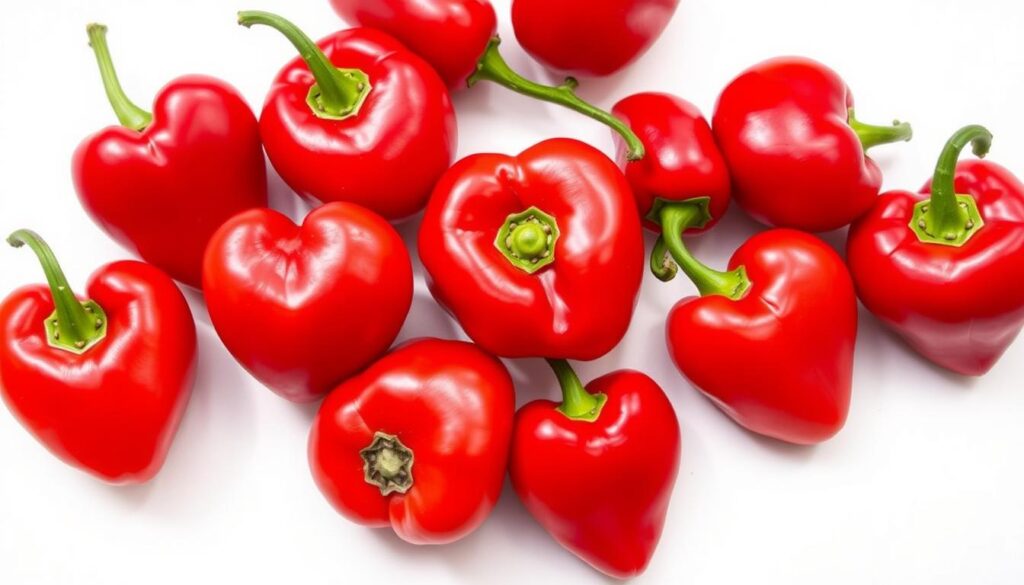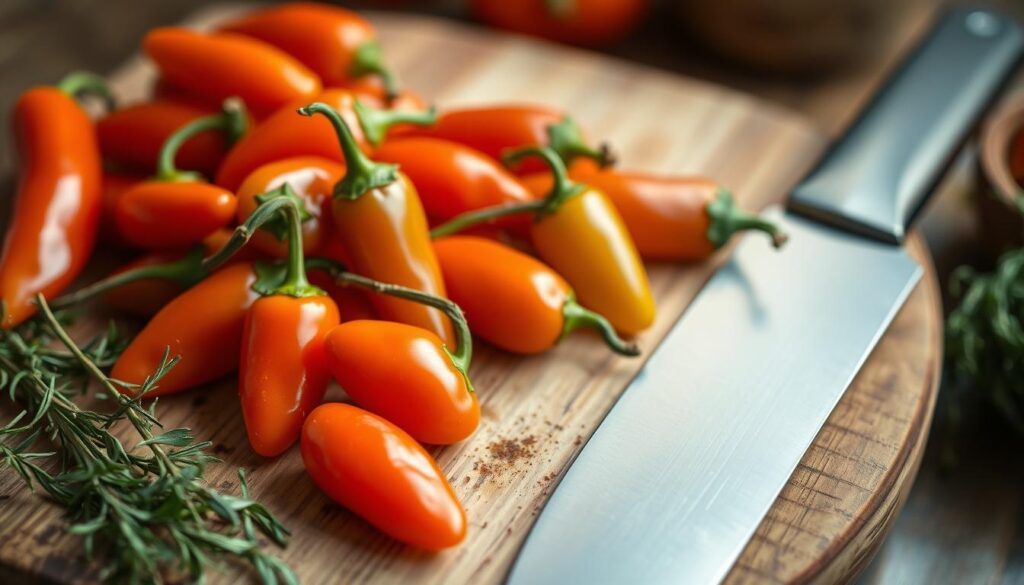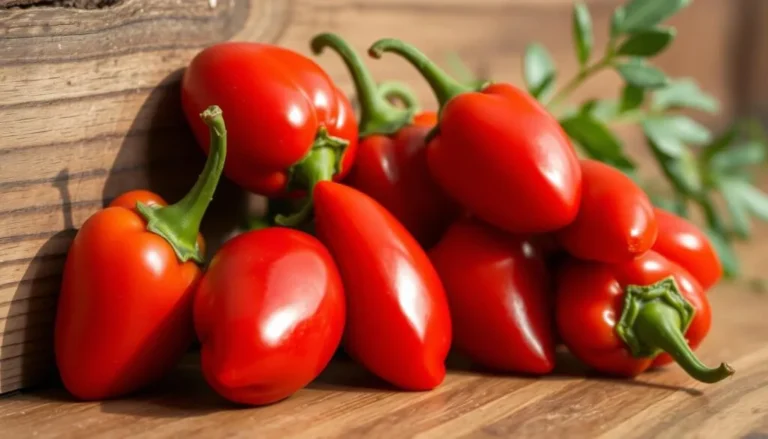I remember the first time I found peppadew at a local charcuterie board. These tiny, vibrant red gems changed my cooking with their sweet yet spicy taste. What are peppadews, you might ask? They’re not just another pepper – they’re a unique culinary treasure that will change your cooking and snacking adventures.
Peppadew are small, distinctive peppers made by Peppadew International Ltd. They’re about 1 to 1.5 inches in diameter, looking like miniature tomatoes with a unique flavor. Unlike hot peppers, peppadew are sweet and mildly spicy, making them very versatile in the kitchen.
The Juanita piquanté variety is a standout in the culinary world. These peppers come in vibrant red and sometimes yellow, adding color to any dish. With a mild heat level of 1000 to 1200 Scoville Heat Units, they give a gentle tingle without overwhelming your taste buds.
Key Takeaways
- Peppadew are small, sweet piquanté peppers
- They have a unique sweet and mildly spicy flavor profile
- Available in red and yellow varieties
- Mild heat level between 1000-1200 Scoville Heat Units
- Trademarked by Peppadew International Ltd.
Table of Contents
What Are Peppadew Peppers?
Peppadew are a unique and intriguing culinary gem. They have captured the attention of food enthusiasts worldwide. These peppers offer a sweet and mildly spicy flavor that makes them stand out.
The story of peppadew starts in the Limpopo province of South Africa, discovered in 1993. Unlike many peppers, these are a trademarked product owned by Peppadew International. This has made them a global culinary sensation.
A Unique Pepper with Fascinating Origins
Peppadew are scientifically classified as Capsicum baccatum. They have an interesting background from South America. These small peppers are between 1 to 1.5 inches in diameter. They have a unique flavor:
- Sweet and fruity initial taste
- Subtle spicy undertone
- Mild heat rating between 500-1,500 Scoville heat units
- Bright red color with a distinctive shape
Distinctive Characteristics
Peppadew are special in the culinary world. Their plants can grow over 4 feet tall and 2 feet wide. They are often sold pickled or brined.
These peppers are loved for their versatility. They are great in salads, sandwiches, appetizers, and antipasto platters. Their journey from a chance discovery to a global ingredient is remarkable. Now sold in over 25 countries, they are a unique culinary treasure.
The Flavor Profile of Peppadew
Peppadew offer a unique taste that’s both sweet and tangy. They also have a gentle heat. This makes them a favorite among food lovers who want to spice up their dishes.
Sweetness Versus Heat
Peppadew are surprisingly mild. They have a Scoville Heat Unit (SHU) rating of 1,177. This is much less spicy than jalapeño peppers.
To understand their heat level, Peppadew are about four times milder than jalapeños. This makes them great for those who like a soft kick.
- Scoville Heat Units: 1,177 SHU
- Comparable to poblano peppers in heat level
- Approximately four times milder than jalapeños
Versatile Culinary Uses
Peppadew are incredibly versatile. They’re perfect for adding flavor to many dishes. Their sweet and tangy taste is ideal for:
- Stuffing with soft cheeses like cream cheese or goat cheese
- Adding to salads for a burst of flavor
- Incorporating into appetizers and charcuterie boards
- Using as a garnish for sandwiches and wraps
The pickling process adds sugar, making them even sweeter. Whether you pick hot or mild varieties, Peppadew can elevate any dish.
Nutritional Benefits of Peppadew
Peppadew are a nutritional powerhouse that can improve your health. These small, vibrant peppers add flavor to your meals. They are packed with essential vitamins and minerals that help your body work its best.
These peppers, similar in size to cherry tomatoes, have a remarkable nutrient profile. They offer more than just great taste. They provide several health benefits:
- Rich in Vitamin C – supports immune system health
- Contains Vitamin A – promotes eye and skin wellness
- Good source of Potassium – helps regulate blood pressure
- Provides Folic Acid – supports cell function and growth
Powerful Antioxidant Properties
Peppadew are full of antioxidants. The capsaicin in them has amazing health benefits. Studies in the journal Nutrients show capsaicin may lower heart disease risk.
Digestive and Heart Health
Research shows Peppadew can help your gut health. Capsaicin may boost microbial diversity in your gut, aiding overall health. They are also low in calories, making them great for healthy diets.
A small pepper with big nutritional potential!
Looking to make your meals healthier? Peppadew are a tasty and nutritious choice. Their mix of vitamins, minerals, and antioxidants makes them a top pick for any diet.
How to Choose Peppadew Peppers
Choosing the right Peppadew can make your cooking better. These peppers have a sweet and spicy taste. Knowing how to pick and where to buy them is key.

When looking for where to buy peppadews, you have two choices: fresh or jarred. Fresh ones are rare outside of South Africa. So, jarred ones are easier to find for most cooks.
Fresh vs. Jarred Peppadews
Jarred Peppadew have many benefits:
- They’re easy to find in stores
- Ready to use right away
- Last longer
- Have a consistent taste
What to Look For in Quality
When picking peppadews, look for these qualities:
- Color: Bright red or orange
- Texture: Firm and full
- Packaging: Sealed and undamaged
- Brine: Clear and clean
| Selection Criteria | Fresh Peppers | Jarred Peppers |
|---|---|---|
| Availability | Extremely Limited | Widely Available |
| Shelf Life | 3-5 Days | 6-12 Months |
| Flavor Intensity | Mild | Consistent |
For buying Peppadew , try specialty stores, gourmet shops, and online. Look in the international or specialty foods section of your local market.
Storing Peppadew Peppers
Keeping peppadew peppers fresh is key to their taste and quality. Whether you have fresh or jarred peppers, knowing how to store them is important. This way, you can enjoy these tasty peppers for a longer time.
Best Practices for Fresh Peppadew Peppers
Here are some tips for keeping fresh peppadew peppers fresh:
- Store fresh peppers in a paper bag in the refrigerator’s crisper drawer
- Keep them away from direct moisture to prevent spoilage
- Use within 5-7 days for optimal taste and texture
- Check regularly for any signs of mold or soft spots
Storage Tips for Jarred Peppadew
Jarred peppadew need special care to keep their flavor:
- Always refrigerate opened jars of peppadew
- Ensure the peppers remain fully submerged in brine
- Use a clean, dry utensil when removing peppers to prevent contamination
- Sealed jarred peppadew can last up to 12 months when properly stored
Knowing how to store peppadew is the first step to using them well. By following these easy tips, you can keep your peppers fresh. This way, they’ll be ready to add flavor to your favorite dishes.
Cooking with Peppadew Peppers
Peppadew peppers add a sweet and tangy flavor to your cooking. They are vibrant and versatile, making your dishes stand out. If you’re curious about using peppadews, get ready for a fun cooking journey.

Peppadew recipes are endless and exciting. These peppers can turn simple dishes into amazing meals. Cooking with peppadews lets you create dishes that wow your loved ones.
Delicious Ways to Incorporate Peppadews
- Stuff peppadews with creamy goat cheese for an elegant appetizer
- Chop and add to salads for a vibrant flavor boost
- Use as a pizza topping for extra zest
- Blend into pasta sauces for a sweet-spicy kick
- Create stuffed peppadew poppers with bacon and cheese
Perfect Pairing Combinations
Peppadew pair well with many ingredients. Try these tasty combinations:
- Goat cheese and crispy bacon
- Grilled chicken and fresh herbs
- Seafood dishes with a light cream sauce
- Roasted vegetable platters
A quick stuffed peppadew recipe takes just 15 minutes. Mix 4 ounces of garlic and herb goat cheese with 2 ounces of cream cheese. Stuff into peppadews, top with chopped bacon and breadcrumbs, and bake at 375°F for 12-15 minutes. These tasty bites can be made up to 24 hours in advance and stored in the fridge.
Pro tip: Experiment with different fillings and pairings to discover your favorite peppadew combinations!
Peppadew Pepper Varieties
Peppadew peppers come in a variety of flavors and heat levels. They can make your cooking more exciting. Knowing the different types helps you pick the right ones for your recipes.
Peppadew International has created many varieties of these peppers. They cater to different tastes. Let’s look at some of the most loved ones:
Common Market Varieties
- Mild Peppadew: Great for those who like a soft flavor but not too spicy
- Hot Peppadew: For those who enjoy a bit of heat in their food
- Goldew: A bright yellow pepper with a sweet taste
Specialty Varieties to Discover
There are also interesting related varieties in the Capsicum baccatum family:
- Aji Amarillo: A Peruvian pepper with a bright yellow color
- Sugar Rush Peach: Known for its sweet, fruity taste
- Lemon Drop pepper: Offers a tangy, citrusy flavor
When picking peppadew peppers, think about how spicy you like them and the flavor you want. Each type has its own special qualities.
Peppadew Peppers in Global Cuisine
Peppadew peppers have become a hit in cooking around the world. They add a sweet-tangy twist to many dishes. Their unique flavor makes them stand out in the kitchen.
Chefs are now using peppadews in new ways. They bring excitement to traditional recipes. Peppadews are loved in kitchens from South Africa to the Mediterranean.
Exciting Regional Dishes
Peppadews are used in many creative dishes:
- South African appetizers with stuffed peppadew peppers
- Mediterranean tapas with peppadew pepper spreads
- North American fusion salads with their sweet-spicy taste
- European charcuterie boards with pickled peppadews
Cultural Culinary Significance
In South African cooking, peppadew peppers mean more than just a flavor. They symbolize innovation and flavor exploration. Chefs around the world see them as a gourmet ingredient that can make simple dishes special.
Their heat level, from 100 to 500 Scoville Heat Units, is perfect for those who want a mild but tasty pepper.
Growing Peppadew Peppers at Home
Growing peppadew peppers at home is exciting and rewarding. These peppers mix sweetness with a mild heat. They can make your cooking much better.
First, learn what are peppadews. These colorful peppers come from South Africa. They need special growing conditions to grow well.
Optimal Growing Conditions
Peppadew peppers need certain conditions to grow well. Here are the main ones:
- Full sun exposure (6-8 hours of direct sunlight daily)
- Well-draining, fertile soil with pH between 6.0-6.8
- Consistent soil temperature around 70-80°F
- Moderate humidity levels
Beginner’s Guide to Cultivation
For beginners, here are some helpful tips:
- Start seeds indoors 8-10 weeks before the last frost
- Use seed trays with quality potting mix
- Maintain consistent moisture without overwatering
- Transplant seedlings after the last frost
| Growth Stage | Care Requirements | Estimated Timeline |
|---|---|---|
| Germination | Warm soil, consistent moisture | 7-14 days |
| Seedling | Indirect sunlight, gentle watering | 4-6 weeks |
| Flowering | Full sun, balanced fertilizer | 8-10 weeks |
| Harvest | Regular picking, monitoring ripeness | 12-16 weeks |
Pro tip: Buy seeds labeled as Malawi Piquanté Pepper for real peppadew varieties. Be patient and keep up the care for a great harvest.
The Popularity of Peppadew Peppers
Peppadew peppers have quickly become a favorite in the U.S. They are loved by food lovers, chefs, and home cooks. They are now a key ingredient in many recipes.
More people in the U.S. want to try unique and tasty ingredients. They are curious about peppadews and how to use them in cooking.
Expanding Market Presence
Peppadew peppers are becoming more popular in the food world. Several reasons explain their growing appeal:
- Available in over 40 countries worldwide
- Approximately 70% of consumers prefer jarred peppadew peppers
- Retail prices range from $3.50 to $6.00 per jar
Culinary Trends
Chefs love peppadew peppers for their unique taste. 60% of them say they are crucial in today’s cooking. Restaurants are adding them to menus, making dishes more interesting.
Looking for where to buy peppadews? You can find them in:
- Specialty grocery stores
- Gourmet food markets
- Online specialty food retailers
- Some major supermarket chains
The global market for pickled peppers, like peppadews, is growing fast. In the U.S., they now make up about 15% of the pepper market. This shows how popular they are becoming.
Conclusion: Why You Should Try Peppadew Peppers
Peppadew peppers are a culinary gem that can change your cooking. They introduce a world of vibrant flavors and new kitchen possibilities. These peppers mix sweetness with a mild heat, making any dish special.
Knowing how to use peppadews is crucial for their full potential. They’re great in salads, sandwiches, or as fancy appetizers. They add nutritional value and color to your meals.
Peppadew peppers come from South Africa but are loved worldwide. They’re more than a condiment; they’re a culinary adventure. Adding them to your cooking brings a new flavor dimension to your dishes.
Don’t stop exploring with Peppadew peppers. Try them in your favorite recipes. You’ll see why they’re a hit with food lovers. Enjoy their unique taste, versatility, and let them spark your next kitchen creation.
FAQ
What exactly are Peppadew peppers?
Peppadew is a trademark for a sweet pepper from South Africa. They are bright red, small, and taste sweet with a hint of spice. These peppers are loved worldwide for their taste and uses in cooking.
Are Peppadew peppers spicy?
Peppadew peppers are very mild, with a heat level of 500-1,000 Scoville Heat Units. They have a sweet flavor with a slight spiciness. This makes them great for those who like less spicy food.
Where can I buy Peppadew peppers?
You can find Peppadew peppers in many places. Look for them in specialty stores, big supermarkets, gourmet shops, and online. They’re usually sold pickled or jarred.
How are Peppadew peppers typically used in cooking?
Peppadew peppers are very versatile. Use them in salads, on pizzas, in appetizers, or stuffed with cheese. They’re also good in salsas, sandwiches, and as a garnish. Their flavor goes well with many dishes.
What are the nutritional benefits of Peppadew peppers?
Peppadew peppers are low in calories but rich in vitamins, especially vitamin C. They have antioxidants that boost your immune system and heart health. They also provide minerals and fiber.
How should I store Peppadew peppers?
Keep jarred Peppadew peppers in the fridge after opening. Make sure they stay covered in brine. Store unopened jars in a cool, dark place. Fresh peppers should be refrigerated and used within a few days.
Can I grow Peppadew peppers at home?
Yes, you can grow Peppadew peppers at home. They need full sun, well-draining soil, and warm weather. While getting authentic seeds might be hard, you can grow similar peppers successfully.
Are Peppadew peppers the same as other red peppers?
No, Peppadew peppers are unique. They have a distinct flavor, unlike other red peppers. They’re smaller, sweeter, and taste different from bell or chili peppers.
How hot are Peppadew peppers compared to other peppers?
Peppadew peppers are very mild. They’re less spicy than jalapeños, habaneros, or poblanos. Their heat is similar to a sweet banana pepper, making them safe for those who don’t like strong spice.
Are Peppadew peppers always pickled?
While Peppadew peppers are often pickled, you can find fresh ones too. The pickling process enhances their flavor and preserves them. That’s why pickled Peppadew peppers are more common.
There are no reviews yet. Be the first one to write one.

